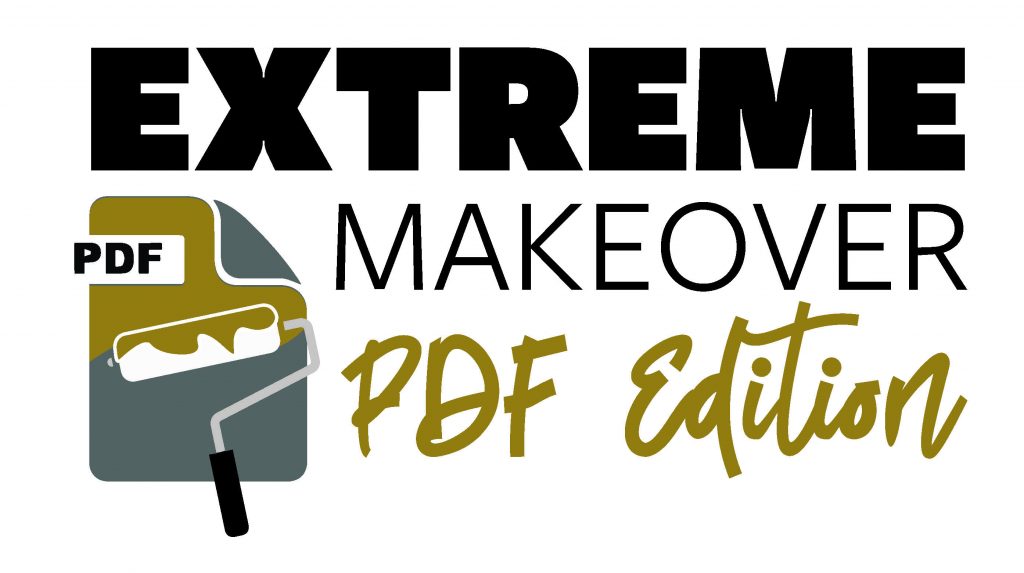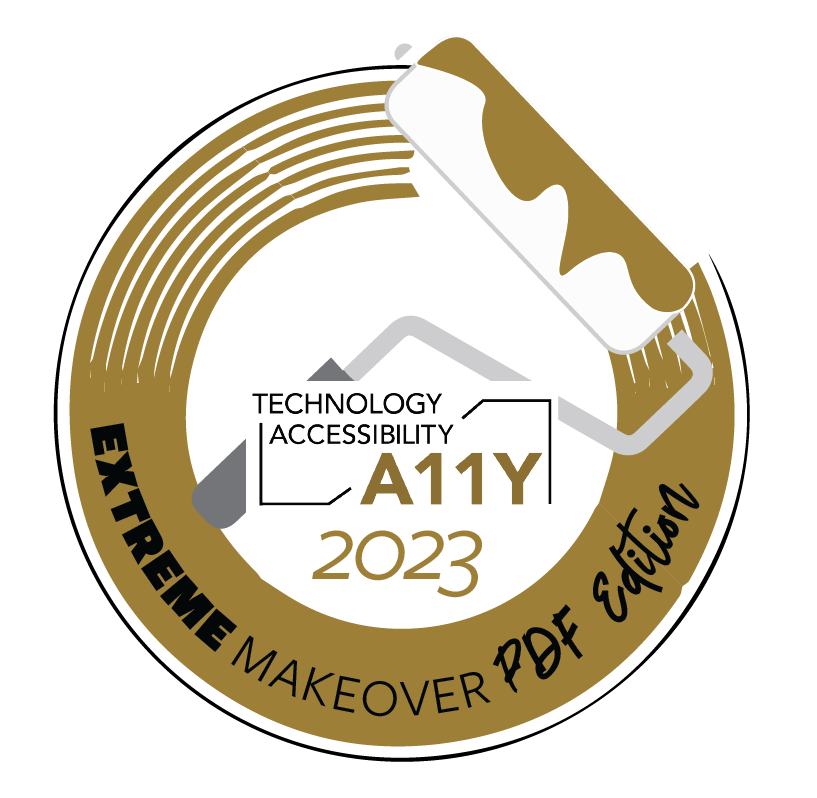Extreme Makeover: PDF Edition 2023

For many years, PDFs were considered the best document type for any and all purposes, but our understanding of technology and users has evolved. If not crafted with attention to accessibility, PDFs can be barriers for individuals with disabilities and can limit your audience. Revising or converting PDFs is an impactful way to make your websites or courses more accessible.
During November and early December, Wake Forest will be holding the third annual Extreme Makeover: PDF Edition! Sponsored by the WFU IS Technology Accessibility Team and the Accessible Content Working Group, this event aims to make websites and courses more inclusive by eliminating inaccessible portable document format (PDF) files.
Each week will have a dedicated theme, and participants will have the opportunity to take on tasks to reduce their inaccessible PDFs: assessing the PDFs available on their site or in their course, creating accessible digital documents and forms, and improving necessary PDFs by adding accessibility features or finding more accessible versions.
Join the Makeover now by completing our online registration form!
Get Involved!
Join faculty and staff colleagues as Wake Forest works together to reduce inaccessible PDF files to make our community even more inclusive to everyone.
Join the Makeover by completing our online registration form!
Makeover Overview
Week 1 (starts Nov. 6) → Learn about accessible documents and why they matter
Participants will learn the benefits of accessible documents and why converting PDFs to other formats, such as web pages, Google Docs, or Canvas pages, or finding newer digital versions of old PDFs can enhance accessibility and maximize efficiency and audience engagement.
Each participant will be provided with a Google sheet of their PDFs (WordPress inventory or their course PDFs). During the first week, we’ll ask you to start considering if your PDFs are from documents you (or a Wake colleague) created or came to you as a PDF from an external source. This can help determine efficient next steps in Week 2.
Note: some of the PDFs listed may not be currently linked on your site, but might be archived in your WordPress media library. Reach out to tap@wfu.edu if you need assistance finding your files!
Join us via Zoom for an optional session on November 9th from 9-10 AM to talk about what makes documents accessible or inaccessible and why sometimes PDFs aren’t the best solution!
Week 1 Resources
- Learn more about why accessible documents matter and how inaccessible documents, including some PDFs, can hinder engagement. Here are some training videos you might find helpful this week:
- This video from LinkedIn Learning provides a general overview of why accessibility is important, including personal and legal motivations.
- These videos from YouTube provide additional context about inaccessible versus accessible PDF documents and Microsoft Word documents.
Week 2 (starts Nov. 13th) → Identify next steps for your PDFs
Participants will dedicate this week to fully assessing the inventory of PDFs on their Google sheet, and marking each PDF with the planned next steps (which we’ll start taking in Weeks 3 and 4). Participants will determine which PDFs are needed but can be converted to another format, which can be removed, and which will need to stay as a PDF (improving it with added accessibility features or by ensuring it is the most accessible existing version).
For web content managers, this exercise can be incredibly helpful because many people find there are old PDFs still available on their websites that are not only inaccessible but outdated. These can be quickly marked for later deletion. Determining which PDFs can be converted to a different accessible format, such as a Google Doc, web page, Canvas page, or web form, often covers many more items in your inventory. (Note: we suggest moving most items you keep to these formats!)
For faculty, many course materials may quickly fall into two major groups, either faculty-created documents like syllabi and assignments, or external PDFs like articles. For those items created by the faculty member, we suggest marking them for an efficient and accessible shift to Canvas pages or Google Docs. For PDFs from external sources, like journals, you may mark them with UDL and in Week 3 we’ll guide you to search for a version most aligned with Universal Design for Learning principles.
All participants can join us via Zoom for an optional session on November 15th from 3-4 PM to learn how to use and review the sheet that lists your PDFs, with conversation and guidance on some good first steps.
Week 2 Tips
As you review your list of PDFs, consider the following:
- If it’s outdated and no longer needed, mark it for deletion.
- If you are not sure which option will work best between web pages, Google Docs, or an accessible PDF, you can add more than one label on your sheet and we can help you decide as the Makeover continues.
- If your document is made for digital sharing and will be updated periodically, especially if it is primarily text, it is a great fit to move to a web page, or a Google Doc if a web page isn’t feasible.
- If you have an elaborately-formatted document that you anticipate your audience will print but might also share digitally, consider putting your info up as a web page, then provide an optional printable and accessible PDF.
- We recommend transforming all PDF forms into more easily accessible formats, like Google Forms. (covered in Week 3).
Week 3 (week of Nov. 27th) → Starting the Renovation
Participants will begin to convert their PDFs to another format, remove those they no longer need, and learn more about how to determine which PDFs might be more or less accessible for those cases when PDFs are unavoidable. Be sure to mark your inventory when each PDF is transformed or removed!
Important note: for PDFs you will convert to another format (Google Doc, Canvas page, website, etc.), first try to locate the original text version (perhaps a Word or Google document). This will make all conversions easier, including for those that have to remain PDFs!
Remember, the Makeover is just a kickoff to ongoing accessibility for documents! It isn’t expected that you’ll be able to completely renovate all of your PDFs right now. Keep working to identify the next steps for your documents and start with those PDFs you know how to address now.
Join us via Zoom for an optional session on November 29th from 10-11 AM to review some basics of creating more accessible Google or Word docs, websites, or Canvas pages as replacements for some of your PDFs. We’ll also discuss choosing more accessible versions of PDFs.
If you have questions or complicated PDFs you’d like to discuss, please reach out to us at tap@wfu.edu to schedule time for a conversation!
Week 3 Tips
- For PDFs identified as outdated or no longer needed, you can choose to delete/remove them from your WordPress Media Library. (If needed, consider archiving elsewhere, like in a Google Drive.)
- For external documents, like journal articles, you may not be able to avoid PDFs but you can choose more accessible versions that align with Universal Design for Learning practices!
- Save time and don’t scan that printed article! A large portion of scholarly material can be found in an existing digital format. These are likely to be more accessible than a scan or an old version of a PDF.
- Look for a document with multiple format options, if possible. ePub and HTML are common alternatives and can be more accessible to some users.
- Link to the digital source (such as at ZSR Library) rather than downloading a file. This gives students a chance to choose a format if there are options available.
- For PDFs that you marked “Convert to Google Doc,” follow these steps.
- For PDFs that you marked “Convert to Google Form,” follow Accessible Google Form best practices.
Week 4 (starts Dec. 4) → Make Remaining PDFs More Accessible
Participants will learn ways to evaluate the accessibility of their remaining PDFs and ways to repair and enhance their accessibility.
Join us for an optional, but highly recommended, two-hour Zoom session on Tuesday December 5th from 9-11AM to review the essentials of remediating PDFs to make them accessible, discuss the tips and concepts shared in the recommended video training. Time for Q&A on this process will be included.
Watch the instructional segments listed in the LinkedIn Learning Extreme Makeover Collection, to learn about the basics of PDF accessibility and remediation within Acrobat.
Choose a PDF marked for remediation on your worksheet and begin the remediation process using what you learned in the videos above as well as the resources shared on this web page. Remediating PDFs can take some time and patience, but practice helps. Reach out to tap@wfu.edu if you want to discuss as you get started!
Week 4 Tip
Once you’re sure your PDF is as accessible as possible, consider modifying the name of your PDF to identify that it has been made accessible. Consider using the term a11y to mark your accessible files.
For example: math_tutorial.pdf to math_tutorial_a11y.pdf.
What’s a11y? Check out this explanation of what a11y means.
Remember: if you rename it for accessibility you should be certain it is as accessible as possible!
Made Possible By:
Accessible Content Working Group
- Gregory Brunick
- Norah Elmagraby
- Davita DesRoches
- Kevin Gilbertson
- Suzanne Hawks
- Brianna Healey
- Shari Lewis
- Jonathan Milam
- Amy Mohan
- Matt Nelkin
- Jeff Nichols
- Don Shegog
- Madi Shaver
- Michael Shuman
- Eudora Struble
- Robert Vidrine
- Lloyd Whitehead
IS Technology Accessibility Team
Jonathan Milam and Eudora Struble
Special thanks to:
- North Carolina State University for originating this event and permitting us to adapt it for our use
- Emily Gregg, IS Digital Media Specialist, for her graphic design expertise

